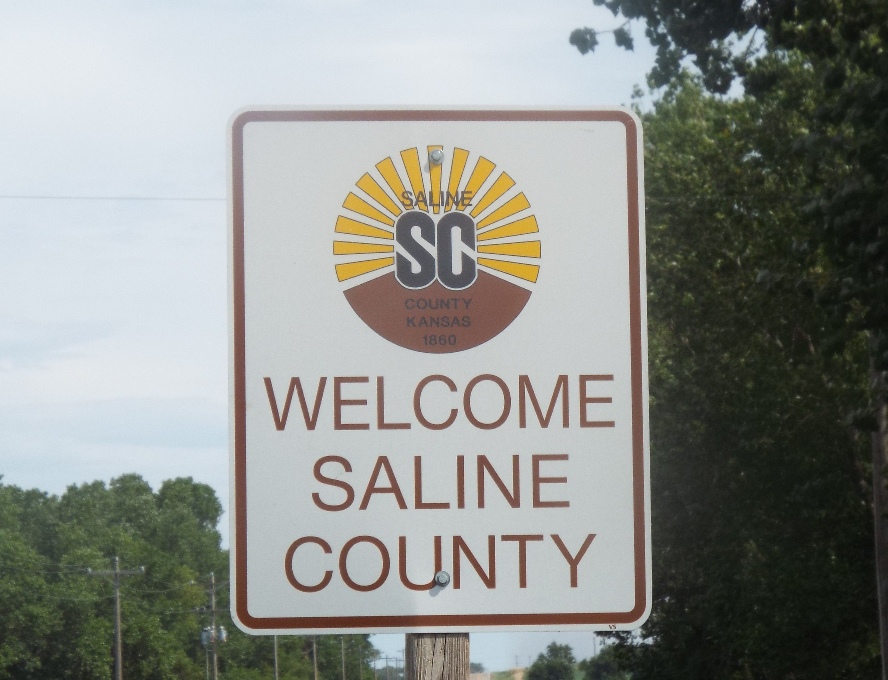All five County Commissioners voted to approve spending $10,000 to fund to help fund a county, city, Saline County Economic Development Organization, K-State University Polytechnic and K-State Manhattan feasibility study to assess the potential for growth aspects.
County Administrator Rita Deister confirmed that the Commission had met previously in executive session on this matter. She declined to say more as this as is protected under “trade secrets” exemptions to the Kansas Open Meeting / Records Act.
The above description was taken from a motion made by Commissioner Mike White that was not repeated for clarification. This unbudgeted expense will be paid for out of the County’s contingency fund.
Proposal to Address Road Annexation Issues Within The City
County Counselor Mike Montoya hoped to receive the blessing of the County Commission to deliver a proposal to the City, outlining which roads the County hoped the City would begin the process of annexing. Commissioners met in executive session for 30 minutes. As the Commission went back into regular session, nothing more was said about the matter.
Earlier, Montoya identified three categories of road that a proposal developed jointly with County Engineer Neil Cable, Road and Bridge Superintendent Darren Fishel, Deister and others. It identified:
- “Trash” roads, used to transport trash to the City’s landfill. Montoya said the proposal encouraged the re-establishment of tipping fees that the City used to collect at the landfill; the City then gave the County up to $180,000/year to help offset the increased cost of maintaining these roads. Montoya said that these roads receive heavier use and there is a need to pick up the trash that comes off of improperly secured loads. A previous agreement included a mechanism for reassessing the amount of the tipping fees every five years.
- Other roads that have become essentially “City” roads. There are “doughnut holes”, where an individual starts off in the City, then travels on a County maintained road, to reach another part of the City. Some suggested that when the City starts platting for subdivisions that might then be annexed into the City, that this would be the time to begin the process of annexing those roads into the City.
- Removing some roads from the annexation lawsuit.
Montoya said that the County is faced with having to reprioritize its resources to pay for trash to be removed from roadways under the present stalemate. Even if jail “trustees” are used to remove trash, the County would still incur costs. Montoya asserted that spending money on any of these options would not address the cause of the problem.
Gravel Road Upgrade
Cable identified 38.5 miles of county gravel roads that have the greatest potential to benefit from upgrading. The report identified the recommendations of four staff that included Fishel, Dennis Cooley, Terry Mattison, and Mark Turner. Shadwick was quick to clarify that “upgrading” does not mean “paving”. It may involve such work as securing rights of way and re-building shoulders. These roads are:
- Water Well Road from Lightville Road to Burma Road—1 mile (awaiting lawsuit appeal ruling)
- Water Well Road from Holmes Road west 0.5 mile—0.5 mile
- Water Well Road from Simpson Road west 0.5 mile—0.5 mile
- Ohio Street from Water Well Road south to K-4 Highway—4 miles
- Simpson Road from Magnolia Road south to K-4 Highway—6 miles
- Schilling Road from Ohio Street east to Flood Control Dike—1 mile
- Magnolia Road from Kipp Road east to County Line—4 miles
- Hedville Road from State Street south to K-140 Highway—3 miles
- Lapsley Road from Old 81 Highway east to Ohio Street—1 mile
- Halstead Road from Crawford Street north to K-140 Highway—0.5 miles
- Burma Road from K-140 Highway north to State Street—0.8 miles
- Holmes Road from North Street south to Magnolia Road—3.5 miles
- Crawford Street from Simpson Road east to Woodward Road—1 mile
- North Street from Eastborough Road east to Simpson Road—1.5 miles
- Marymount Road from North Street north to Old 40 Highway—0.8 miles (awaiting lawsuit appeal ruling)
- Niles Road from County Club Road north to Old 40 Highway—3 miles
- Simpson Road from Old 40 Highway north to Shipton Road—3 miles
- Thacher Road from Ohio Street east to Crystal Springs Road—1.5 miles
- Ohio Street from just south of Humbargar Road north to County Line—1.2 miles
- Gerard Road from Lockard Road north to Humbargar Road—0.75 miles
- Shipton Road from Halstead Road east to K-143 Highway—3 miles
- Pleasant Hill Road from Halstead Road east to K-143 Highway—3 miles
Cable noted that the City lacks a “green road” that allows motorists to quickly travel around the city. He said that while Ohio Street had originally been considered to be a “green road”, it has many stoplights and driveways where motorist back out onto the road. There was some discussion if Holmes Road might serve this purpose or if plans for a “green road” need to go further east.
Some of the proposed roads are part of annexation issues with the City. Cable also said that “any paved road will draw traffic”. Cable also noted that the County’s standards for building roads are different than the City’s—which include building curbs and gutters.
Cable said that the process of upgrading the proposed 38.5 miles of gravel roads would be slow. He recommended “starting a section and seeing it through to completion” as preferred to “hopscotching” to develop smaller segments of road. Cable noted that rural residents may complain if they don’t see upgrading occurring in the area where they live.
Fishel and Cable acknowledged that residents may have valid concerns about the condition of the remaining 670+ miles of road that aren’t being considering for upgrading. Fishel was open to looking at other maintenance practices that might improve road conditions. Commissioners were asked if they might want to hold meetings with their constituents to seek their input.
Shadwick complemented Cable and other contributors by saying, “You all have given us information that will help with the budget. We’ve been given something that’s well thought out. It’s a plan.”
Fishel said that there are also some gravel roads that could more accurately be designated as earthen roads. Commissioners saw this as a starting point and asked Fishel to develop this idea further, designate what roads might be involved, and bring this back to the Commission.
Allowing Gypsum Creek to Follow Its Natural Tendency to Change Channels
Commissioner Robert Vidricksen had received concerns from residents near Kingman Road, north of where Gypsum Avenue intersects Gypsum Creek. With rainfalls of 2 or 3 inches, Gypsum Creek is rising out of its banks.
Cable said that in 1985, a 220 foot bridge was built to replace an older truss bridge. Years ago, the runoff from Spring Creek was directed to Gypsum Creek.
Nearby residents are asking that the creek bank be built up so water will stay in the creek when there is a soaking rain. Cable explained that removing trees and silt won’t resolve the problem to the long-term satisfaction of residents. Cable said that what residents are proposing would cost $25,000-$30,000 but offered a detailed explanation that those efforts “wouldn’t change things”. He said the river naturally is wanting to cut a new channel. Fishel concurred, saying “There is no remedy. People in Gypsum have been shoveling dirt around.” Fishel said runoff from rains in McPherson is contributing to the creek going outside its present banks.
Road and Bridge Staff Request Ability to Work Four, 10 Hour Shifts per Week
Tim Crough represented some R&B staff who sought to allow staff to work four, 10 hour shifts during the summer. Existing County policies give department heads the option of shifting work hours from 8:00 AM – 4:30 PM to 7:00 AM – 3:30 PM.
Representing SCAPE (Saline County Public Employees), Terry Mattison said the SCAPE work agreement gives Fishel authority to change work hours broadly. Mattison noted that in 2014, previous commissioners abruptly changed the work agreement, without prior notice to SCAPE. Mattison asked that Commissioners address the discrepancies between the county policy and the work agreement.
Spirited discussion about keeping hours the same, moving to summer hours, or changing the work day were expressed by four other R&B staff members. Commissioners asked that Fishel survey staff as to their preferences. Shadwick said that while the Commission will consider employee input, the Commission will have to weigh a variety of factors as it makes a decision.
In other matters:
- County Treasurer Jim DuBois told Commissioners that interest on idle funds, year-to-date for 2017 is $63,000—which is up from the year-to-date for 2016 is $52,000. He expressed hope that interest on idle funds might reach $200,000 for 2017. Deister said the County used to earn as much as $1,000,000 in interest on idle funds prior to 2007.
- Signed a letter supporting the Smoky Hill Weapons Range joint land use study.
- Received the Drug Task Force’s Annual Report on money and property seized from forfeitures.
- Heard a request to extend fiber optic cable out to R&B from various starting points. Computer Technologies Director Brad Bowers said that an existing system with Cox Cable only provides three bandwidths and frequently goes down when it rains. This becomes problematic around payroll or bill paying deadlines. Nex-Tech is able to make the connection for $24,510. Nex-Tech can also provide 15 bandwidths, but the monthly service cost will increase from $372 to $672. Money for this update had not been included in R&B’s 2017 budget, though some building funds are available.
- R&B has issued requests for proposals to renovate its office space. Proposals for service are due back by May 12 and interviews for those submitting the best proposals are planned for May 23.
]



